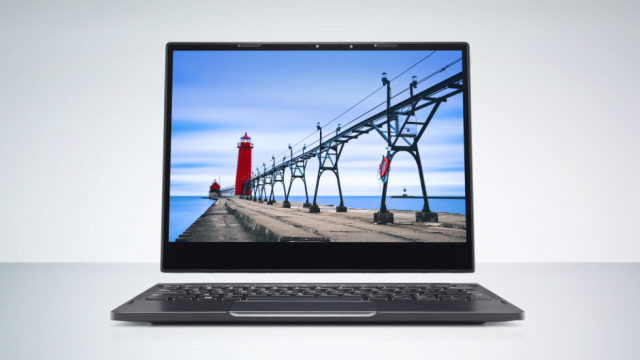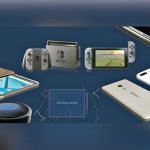The gear that shined at the year’s biggest tech show
Wallpaper-thin TVs, drones that can dive underwater, and a computer the size of a credit card. Those are only a few of the gadgets that have been unveiled this week at the annual CES gadget expo in Las Vegas, where companies in the tech, automotive, and home appliance industries flaunt their latest innovations.
Many high-profile tech companies, like Apple and Google, typically hold their own separate events throughout the year to unveil new products rather than debuting new wares at CES. Still, the annual convention, now in its 50th year, often provides a look at the next big trends in tech.
The biggest themes at CES this year include self-driving cars, home robots, and tons of integrations with Amazon’s Alexa voice assistant. We also saw razor-thin laptops and convertible computers, along with show-stopping massive televisions.
Here’s a look at some of the most interesting gadgets at CES 2017:
-
Dell 2-in-1 Laptops

Dell Dell introduced several convertible laptops this year, and the most notable include its Latitude 7285 and new XPS 13 models. The former is a Surface Pro 4 rival that includes a sharp screen, stylus, and a sturdy keyboard that more closely resembles that of a laptop than most hybrids. The latter is an updated version of Dell’s already great XPS 13 that includes a flexible rotating hinge for use in different positions. -
Lenovo Smart Assistant

Lenovo Lenovo’s new speaker is a slightly cheaper and more colorful alternative to the Amazon Echo. It includes eight microphones that Lenovo says can pick up speech from 16 feet away. It’s also powered by Amazon’s Alexa voice assistant, meaning you’ll get access to the same array of “skills” that you would with Amazon’s own gadget. Similarly, Lenovo is touting the Smart Assistant as ideal for tasks like answering questions, managing calendars and to-do lists, and playing music. It launches this May in several colors and will cost $130 for the standard model and $180 for a version with upgraded Harman Kardon speakers. -
Razer Project Valerie

Razer When you’re using a laptop for doing work, playing video games, and streaming Netflix, one screen isn’t always enough. So why not include three? Razer’s Project Valerie concept does just that by adding two foldable displays that expand out from the primary screen in the center. Each display is 17 inches diagonally and supports 4K resolution, and Razer says they can be used independently or together as one giant display. The downside: it weighs 12 pounds, which isn’t unacceptable for a beefy gaming laptop but is way more than the average notebook. -
Asus Zenfone AR

Asus Asus is betting that in the near future we’ll be using our phones for way more than hailing Ubers, playing games, and video chatting. The Zenfone AR, as its name implies, is built to provide augmented and virtual reality experiences. It supports two platforms created by Google to enable these technologies: Tango and Daydream, meaning its hardware is tailored to track motion, perceive depth, and learn about its surroundings to run AR and VR apps. -
Toyota Concept-i

Toyota Toyota doesn’t believe the future of the car is only about teaching vehicles to drive for us. While the Concept-i vehicle shown at CES would be capable of driving autonomously, its biggest draw is the artificial intelligence that powers it. Toyota claims the car will be able to learn more about the drivers’ preferences and needs over time, such as suggesting destinations after a driver chats with the vehicle’s virtual assistant, called “Yui.” -
Intel’s Credit Card-Sized Computer

Intel While some laptop and desktop computers are designed to be customized and upgraded, Intel is thinking about how we’ll be upgrading the various Internet-connected home appliances and robots we may own in the future. Intel’s Compute Card, which is about the size of a credit card, is a mini-computer designed to be easily inserted into smart devices. The idea is to make upgrading gadgets like smart refrigerators, interactive retail kiosks, and connected security cameras as easy as swapping out one component. This prevents the need to buy an entirely new system once new standards in connectivity or faster processors are released. The computer includes essentially all of the same aspects of a standard-sized computer, including a processor, memory, storage, and wireless tech. -
PowerRay Aquatic Drone

PowerVision via YouTube PowerVision’s new PowerRay drone sounds like a fisherman’s dream. The waterproof vehicle is compatible with an optional FishFinder add-on that uses a sonar system to detect fish and send images to the user. It operates in both fresh and salt water and includes a 4K camera that can shoot 12-megapixel stills. -
LG W-Series TV

LG LG hopes to make large-screened TVs blend into the living room as naturally as wallpaper. The company’s new 77-inch TV is incredibly thin and light for its size, weighing just over 27 pounds, Similarly-sized smart TVs from Samsung and Sony weigh around 80 and 73 pounds respectively. That’s because LG’s new TV is designed differently; the screen itself is separated from the guts of the system, which are contained in a Dolby Atmos sound bar that also includes I/O ports for connectivity. -
Mattel Aristotle

Mattel Mattel’s Aristotle is like a smart baby monitor and Amazon Echo rolled into one. The smart voice-activated speaker works with a companion camera and is intended to help with tasks like soothing a crying baby, buying more diapers, encouraging kids to mind their manners, or helping them learn a foreign language. -
Mohu Airwave

Mohu While cord-cutting has improved the binge-watching experience in many ways, its Achilles heel has always been its lack of local broadcast TV offerings. Antenna maker Mohu hopes to address this with its new Airwave, a $150 wireless antenna that brings local channels to platforms like Roku, Apple TV, Fire TV, Android, and iOS. It makes live TV viewable through an app, making it possible to access in the same way you would Netflix or Hulu. [Source:-TIME]







